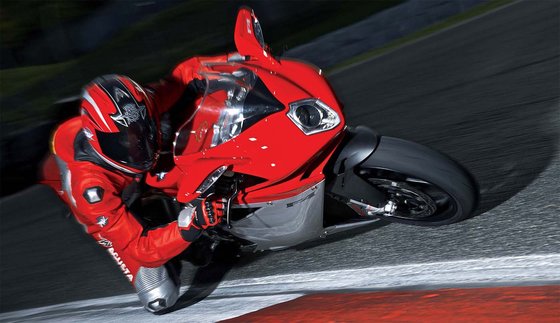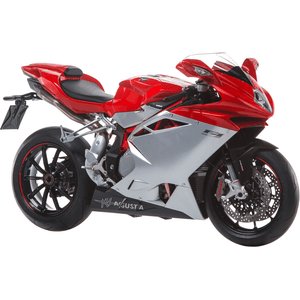MV Agusta F4 1000 [2010-2012]: A Symphony of Italian Engineering

When the MV Agusta F4 1000 rolls into view, time seems to pause. This isn’t just a motorcycle—it’s a statement, a work of art draped in carbon fiber and passion. Produced between 2010 and 2012, this generation of the F4 1000 remains a benchmark for what a superbike can be: a blend of raw power, razor-sharp handling, and design that transcends trends. After spending days with this machine, it’s clear why it’s often called the “Ferrari of motorcycles.” Let’s dive into what makes this Italian icon unforgettable.
Design: Beauty as a Engineering Principle

The F4 1000 is a masterclass in aesthetics. Its silhouette—low, wide, and predatory—is unmistakable. The trellis frame, a signature of MV Agusta, isn’t just structural; it’s a visual exclamation point, contrasting with the sculpted fairings. The quad-exit “organ pipe” exhaust under the tail? Pure theater. Even minor details, like the LED taillight integrated into the aerodynamic winglets, scream intentionality.
Color options were bold yet refined: gray/red, white/gray, and gloss black schemes emphasized its racing pedigree. The 2012 F4 R Corsa Corta added titanium accents and a shorter stroke engine, but every model in this generation shared the same DNA—aggressive lines, a 2100 mm (82.7-inch) length, and a seat height of 830 mm (32.7 inches) that positions the rider in a committed, track-ready stance.
Engine & Performance: A 13,000 RPM Symphony

At the heart of the F4 1000 lies a 998cc inline-four engine, a masterpiece of mechanical aggression. With 192 HP at 13,000 RPM and 112 Nm (82.6 lb-ft) of torque at 9,100 RPM, this isn’t an engine—it’s a controlled explosion. The Corsa Corta (“short stroke”) variant revved even higher, thanks to a 79.0 x 50.9 mm bore/stroke ratio, reducing piston speed for improved reliability at stratospheric RPMs.
Twist the throttle, and the engine responds with a metallic howl that crescendos into a deafening roar. The powerband is relentless, pulling hard from 6,000 RPM until the redline. Yet, the Torque Shift System (TSS)—variable-length intake ducts—ensures usable midrange grunt. Acceleration is brutal: 0-100 km/h (0-62 mph) vanishes in under 3 seconds, and the claimed 297.6 km/h (184.9 mph) top speed feels attainable on a closed circuit.
The 6-speed gearbox is precise, though the clutch demands a firm hand. For track use, the slipper clutch prevents rear-wheel hop during aggressive downshifts. Fueling via the Magneti Marelli IAW 7BM ECU is crisp, and the MK II Traction Control (adjustable across 8 levels) adds a layer of security without dulling the experience.
Chassis & Handling: Precision Meets Passion

MV Agusta’s CrMo steel trellis frame and aluminum swingarm pivot plates create a chassis that’s both stiff and communicative. Paired with a 23.5° rake and 104 mm (4.1-inch) trail, the F4 1000 carves corners with surgical precision. The front 50mm Marzocchi USD forks and rear Sachs monoshock (both fully adjustable) handle bumps with composure, though the 115 mm (4.5-inch) ground clearance demands caution over rough roads.
At 192 kg (423 lbs) dry, the F4 feels lighter than its specs suggest. Flicking it into hairpins is intuitive, and the Brembo Monobloc calipers (320mm dual discs upfront) deliver stopping power that’s as dramatic as the acceleration. The 190/55-ZR17 rear tire provides ample grip, though the aggressive riding position—830 mm (32.7-inch) seat height, low bars—can tire wrists on long rides.
Technology: Ahead of Its Time

In 2010, the F4 1000’s tech suite was revolutionary. The TSS variable intake and 4-2-1-4 exhaust optimized airflow for both low-end torque and high-RPM power. The dashboard, a CAN-bus-enabled digital display, offered lap timers, gear indicators, and traction control settings—features rivals like the Ducati 1198 lacked.
The xenon headlight (a first for production bikes) and LED turn signals showcased MV’s obsession with innovation. Even the mirrors were aerodynamic sculptures, reducing turbulence at speed.
Competition: How the F4 Stacks Up
The F4 1000’s rivals in 2010-2012 included:
- Ducati 1198 Panigale:
- 170 HP, 132 Nm torque
- L-twin character with visceral low-end punch
- Heavier at 195 kg (430 lbs) but more comfortable for street riding
-
Lacked the F4’s electronic aids and top-end rush
-
Yamaha YZF-R1:
- 182 HP, 115 Nm torque
- Crossplane crankshaft for smoother power delivery
-
More refined electronics but less exotic appeal
-
Aprilia RSV4 Factory:
- 180 HP, 115 Nm torque
- Adjustable chassis geometry and V4 engine character
- Closest in spirit to the F4 but less visually striking
The F4 1000 stood out with its higher top speed, Italian exclusivity, and race-bred aesthetics. However, it demanded more maintenance than its Japanese rivals and lacked their practicality for daily riding.
Maintenance: Keeping the Legend Alive

Owning an F4 1000 is a commitment. Here’s what to prioritize:
- Valve Adjustments:
- Intake valves: 0.15–0.24 mm (cold)
- Exhaust valves: 0.20–0.29 mm (cold)
-
Required every 12,000 km (7,500 miles)
-
Oil Changes:
- Use SAE 10W-60 fully synthetic oil (4.2L with filter)
-
Replace every 5,000 km (3,100 miles)
-
Chain Care:
- 15/41 sprocket combo wears quickly under hard use
-
Clean and lubricate every 500 km (310 miles)
-
Brake Fluid & Coolant:
- DOT 4 fluid flush every 2 years
-
Coolant replaced every 24,000 km (15,000 miles)
-
Tire Pressures:
- 2.3 bar (33 psi) front/rear for street riding
Recommended Upgrades from MOTOPARTS.store:
- Aftermarket exhaust systems (Euro 3-compliant options)
- Ergonomic rearsets for improved comfort
- Sintered brake pads for enhanced bite
Final Thoughts: A Machine for the Connoisseur

The MV Agusta F4 1000 [2010–2012] isn’t for everyone. It’s a demanding, high-strung masterpiece that rewards skill and patience. But for those who crave a motorcycle that blends art, speed, and engineering audacity, nothing else compares. From the scream of its radial-valve engine to the way it draws crowds at every stoplight, the F4 1000 is a relic of passion in an increasingly pragmatic world.
Whether you’re tracking down a used model or upgrading your current F4, MOTOPARTS.store has the expertise and components to keep this legend alive. Because owning an MV Agusta isn’t just maintenance—it’s stewardship of a masterpiece.








Specifications sheet
| Engine | |
|---|---|
| Stroke: | Four-stroke |
| Max power: | 195 kW | 261.0 hp |
| Max torque: | 112 Nm |
| Fuel system: | Magneti Marelli IAW 7BM integrated ignition-injection system with Mikuni 49mm throttle bodies, TSS variable intake |
| Max power @: | 13000 rpm |
| Displacement: | 998 ccm |
| Max torque @: | 9100 rpm |
| Bore x Stroke: | 79.0 x 50.9 mm (3.1 x 2.0 in) |
| Configuration: | Inline |
| Cooling system: | Liquid with separate oil radiator |
| Compression ratio: | 13.4:1 |
| Number of cylinders: | 4 |
| Valves per cylinder: | 4 |
| Dimensions | |
|---|---|
| Wheelbase: | 1430 mm (56.3 in) |
| Dry weight: | 192 |
| Seat height: | 830-860 mm (32.7-33.8 in) adjustable |
| Overall width: | 750 mm (29.5 in) |
| Overall length: | 2100 mm (82.7 in) |
| Ground clearance: | 115 mm (4.5 in) |
| Fuel tank capacity: | 17 L (4.5 US gal) |
| Drivetrain | |
|---|---|
| Final drive: | chain |
| Gear ratios: | ['1st: 14/37 (134.1 km/h @ 13700 rpm)', '2nd: 16/33 (171.8 km/h @ 13700 rpm)', '3rd: 18/31 (205.8 km/h @ 13700 rpm)', '4th: 20/30 (236.3 km/h @ 13700 rpm)', '5th: 22/29 (268.9 km/h @ 13700 rpm)', '6th: 21/25 (297.6 km/h @ 13700 rpm)'] |
| Transmission: | 6-speed constant mesh |
| Rear sprocket: | 41 |
| Front sprocket: | 15 |
| Electrical | |
|---|---|
| Battery: | 12V 8.6Ah |
| Headlight: | Xenon with LED parking lights |
| Alternator: | 350W @ 5000 rpm |
| Instrumentation: | Digital CAN-line dashboard with traction control status, lap timer, and gear indicator |
| Maintenance | |
|---|---|
| Engine oil: | 10W60 |
| Brake fluid: | DOT 4 |
| Spark plugs: | NGK CR9EB or CR9EIX |
| Fork oil type: | SAE 7.5W |
| Spark plug gap: | 0.7 |
| Coolant capacity: | 1.9 |
| Forks oil capacity: | 1.44 |
| Engine oil capacity: | 4.5 |
| Chain maintenance interval: | Every 500 km or after wet rides |
| Engine oil change interval: | Every 5000 km or annually |
| Valve clearance (intake, cold): | 0.15–0.24 mm |
| Valve clearance check interval: | 24,000 km / 15,000 mi |
| Valve clearance (exhaust, cold): | 0.20–0.29 mm |
| Recommended tire pressure (rear): | 2.3 bar (33 psi) |
| Recommended tire pressure (front): | 2.3 bar (33 psi) |
| Special Features | |
|---|---|
| Exhaust: | 4-2-1-4 titanium system with adjustable sound valve |
| Traction control: | MK II system with 8 adjustable levels |
| Swingarm adjustability: | Adjustable pivot height for geometry tuning |
| Quick-release front axle: | Race-derived rapid wheel change system |
| Chassis and Suspension | |
|---|---|
| Frame: | CrMo Steel tubular trellis with aluminum swingarm pivot plates |
| Trail: | 100.4 mm (3.95 in) |
| Rear tire: | 190/55-z-17 |
| Front tire: | 120/70-z-17 |
| Rear brakes: | Single 210mm disc, Brembo 4-piston caliper |
| Front brakes: | 2x 320mm floating discs, Brembo radial monobloc 4-piston calipers |
| Rear suspension: | Progressive Sachs monoshock with high/low-speed compression damping, rebound, and preload adjustment |
| Front suspension: | 50mm Marzocchi USD forks, adjustable rebound/compression damping and preload |
| Rear wheel travel: | 120 mm (4.7 in) |
| Front wheel travel: | 120 mm (4.7 in) |



















